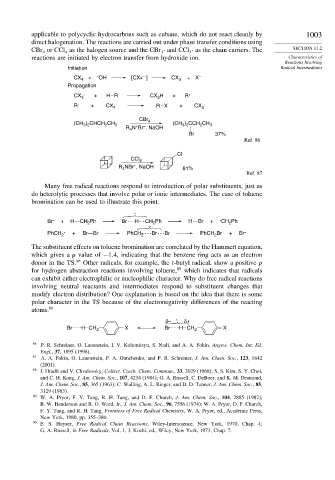Page 1019 - Advanced Organic Chemistry Part A - Structure and Mechanisms, 5th ed (2007) - Carey _ Sundberg
P. 1019
applicable to polycyclic hydrocarbons such as cubane, which do not react cleanly by 1003
direct halogenation. The reactions are carried out under phase transfer conditions using
CBr or CCl as the halogen source and the CBr · and CCl · as the chain carriers. The SECTION 11.2
4
4
3
3
reactions are initiated by electron transfer from hydroxide ion. Characteristics of
Reactions Involving
Initiation Radical Intermediates
–.
CX 4 + – OH [CX4 ] CX 3 . + X –
Propagation
. .
CX 3 + HR CX H + R
3
R . + CX 4 R X + CX 3 .
CBr
(CH ) CHCH CH 3 4 (CH ) CCH CH 3
2
3 2
2
3 2
–
+
R N Br , NaOH
4
Br 37%
Ref. 86
Cl
CCl 4
–
R NBr , NaOH 81%
4
Ref. 87
Many free radical reactions respond to introduction of polar substituents, just as
do heterolytic processes that involve polar or ionic intermediates. The case of toluene
bromination can be used to illustrate this point.
.
. .
Br + H CH Ph Br H CH Ph H Br + CH Ph
2
2
2
.
. .
PhCH 2 + Br Br PhCH 2 Br Br PhCH Br + Br
2
The substituent effects on toluene bromination are correlated by the Hammett equation,
which gives a value of −1 4, indicating that the benzene ring acts as an electron
donor in the TS. 88 Other radicals, for example, the t-butyl radical, show a positive
for hydrogen abstraction reactions involving toluene, 89 which indicates that radicals
can exhibit either electrophilic or nucleophilic character. Why do free radical reactions
involving neutral reactants and intermediates respond to substituent changes that
modify electron distribution? One explanation is based on the idea that there is some
polar character in the TS because of the electronegativity differences of the reacting
atoms. 90
.
δ– δ+
Br H CH 2 X Br H CH 2 X
86
P. R. Schreiner, O. Lauenstein, I. V. Kolomitsyn, S. Nadi, and A. A. Fokin, Angew. Chem. Int. Ed.
Engl., 37, 1895 (1998).
87 A. A. Fokin, O. Lauenstein, P. A. Gunchenko, and P. R. Schreiner, J. Am. Chem. Soc., 123, 1842
(2001).
88
J. Hradil and V. Chvalovsky, Collect. Czech. Chem. Commun., 33, 2029 (1968); S. S. Kim, S. Y. Choi,
and C. H. Kong, J. Am. Chem. Soc., 107, 4234 (1984); G. A. Russell, C. DeBoer, and K. M. Desmond,
J. Am. Chem. Soc., 85, 365 (1963); C. Walling, A. L. Rieger, and D. D. Tanner, J. Am. Chem. Soc., 85,
3129 (1963).
89 W. A. Pryor, F. Y. Tang, R. H. Tang, and D. F. Church, J. Am. Chem. Soc., 104, 2885 (1982);
R. W. Henderson and R. O. Ward, Jr., J. Am. Chem. Soc., 96, 7556 (1974); W. A. Pryor, D. F. Church,
F. Y. Tang, and R. H. Tang, Frontiers of Free Radical Chemistry, W. A. Pryor, ed., Academic Press,
New York, 1980, pp. 355–380.
90
E. S. Huyser, Free Radical Chain Reactions, Wiley-Interscience, New York, 1970, Chap. 4;
G. A. Russell, in Free Radicals, Vol. 1, J. Kochi, ed., Wiley, New York, 1973, Chap. 7.

